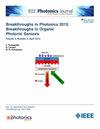基于迁移学习的轨道角动量模式识别方法
IF 2.1
4区 工程技术
Q3 ENGINEERING, ELECTRICAL & ELECTRONIC
引用次数: 0
摘要
涡旋光束在自由空间光通信信道中的传输过程中,大气湍流会引起波前相位干扰,使轨道角动量(OAM)模式识别变得更加困难。此外,该模型需要大量的训练数据集,这大大延长了训练时间。本文提出了一种将迁移学习与改进的卷积神经网络(CNN)相结合的方法来识别畸变涡旋光束的OAM模式。与没有迁移学习的方法相比,该方法保持了更高的准确率,同时显著减少了训练时间和所需的计算资源。分析了不同大气湍流强度和传播距离下模型对OAM模式识别精度的影响,并与传统CNN模型和其他文献的CNN模型进行了比较。为了验证该模型在恶劣天气条件下的识别性能,分析了降雨强度和雾浓度变化对识别精度的影响。此外,在单数据集和混合数据集上训练后,对模型的泛化能力进行了评估。结果表明,本文方法的识别精度优于传统CNN模型和其他文献中的CNN模型,在强湍流条件下传播3 km后,识别精度达到95.6%。在强湍流、强降雨和大雾条件下,1 km处的识别精度分别为89.4%和88.7%。在混合数据集上训练的模型识别准确率达到97.08%,具有较强的泛化能力。本文提出的方法在有效减少计算资源和训练时间的同时实现了较高的识别精度,对OAM模式识别的研究具有重要意义。本文章由计算机程序翻译,如有差异,请以英文原文为准。
Orbital Angular Momentum Modes Recognition Method Based on Transfer Learning
During the transmission of vortex beams in free-space optical communication channels, atmospheric turbulence causes wavefront phase disturbances, making identifying orbital angular momentum (OAM) modes more difficult. Additionally, the model requires extensive training datasets, which significantly prolongs the training time. In this paper, a method combining transfer learning with an improved convolutional neural network (CNN) is proposed to identify the OAM modes of distorted vortex beams. Compared to methods without transfer learning, this approach maintains higher accuracy while significantly reducing the training time and computational resources required. Furthermore, the impact of the model on OAM modes recognition accuracy is analyzed under varying atmospheric turbulence intensities and propagation distances, with comparisons made against traditional CNN models and the CNN models of other literature. To verify the recognition performance of the proposed model under adverse weather conditions, the impact of varying rainfall intensity and fog concentration on recognition accuracy was analyzed. In addition, the generalization ability of the model is evaluated after training on both single and mixed datasets. The results demonstrate that the recognition accuracy of the proposed method surpasses that of the traditional CNN models and the CNN models of other literature, achieving a 95.6% accuracy after 3 km of propagation under strong turbulence. Under strong turbulence, heavy rainfall, and heavy fog, the recognition accuracy at 1 km is 89.4% and 88.7%, respectively. Additionally, the model trained on the mixed dataset achieves a recognition accuracy of 97.08%, indicating robust generalization capability. The method proposed in this paper achieves high recognition accuracy while effectively reducing computational resources and training time, which is of great significance to the research on OAM modes recognition.
求助全文
通过发布文献求助,成功后即可免费获取论文全文。
去求助
来源期刊

IEEE Photonics Journal
ENGINEERING, ELECTRICAL & ELECTRONIC-OPTICS
CiteScore
4.50
自引率
8.30%
发文量
489
审稿时长
1.4 months
期刊介绍:
Breakthroughs in the generation of light and in its control and utilization have given rise to the field of Photonics, a rapidly expanding area of science and technology with major technological and economic impact. Photonics integrates quantum electronics and optics to accelerate progress in the generation of novel photon sources and in their utilization in emerging applications at the micro and nano scales spanning from the far-infrared/THz to the x-ray region of the electromagnetic spectrum. IEEE Photonics Journal is an online-only journal dedicated to the rapid disclosure of top-quality peer-reviewed research at the forefront of all areas of photonics. Contributions addressing issues ranging from fundamental understanding to emerging technologies and applications are within the scope of the Journal. The Journal includes topics in: Photon sources from far infrared to X-rays, Photonics materials and engineered photonic structures, Integrated optics and optoelectronic, Ultrafast, attosecond, high field and short wavelength photonics, Biophotonics, including DNA photonics, Nanophotonics, Magnetophotonics, Fundamentals of light propagation and interaction; nonlinear effects, Optical data storage, Fiber optics and optical communications devices, systems, and technologies, Micro Opto Electro Mechanical Systems (MOEMS), Microwave photonics, Optical Sensors.
 求助内容:
求助内容: 应助结果提醒方式:
应助结果提醒方式:


